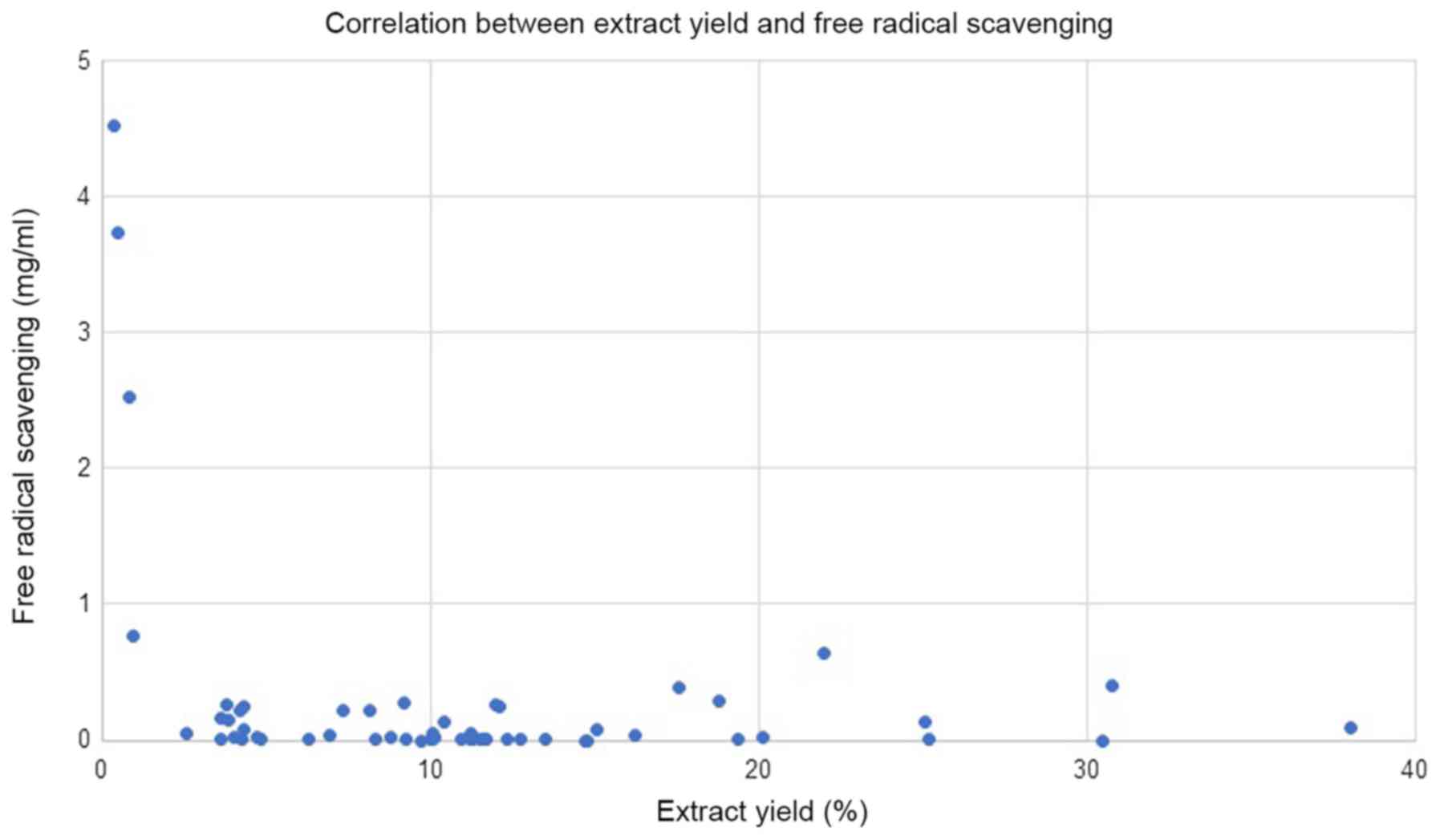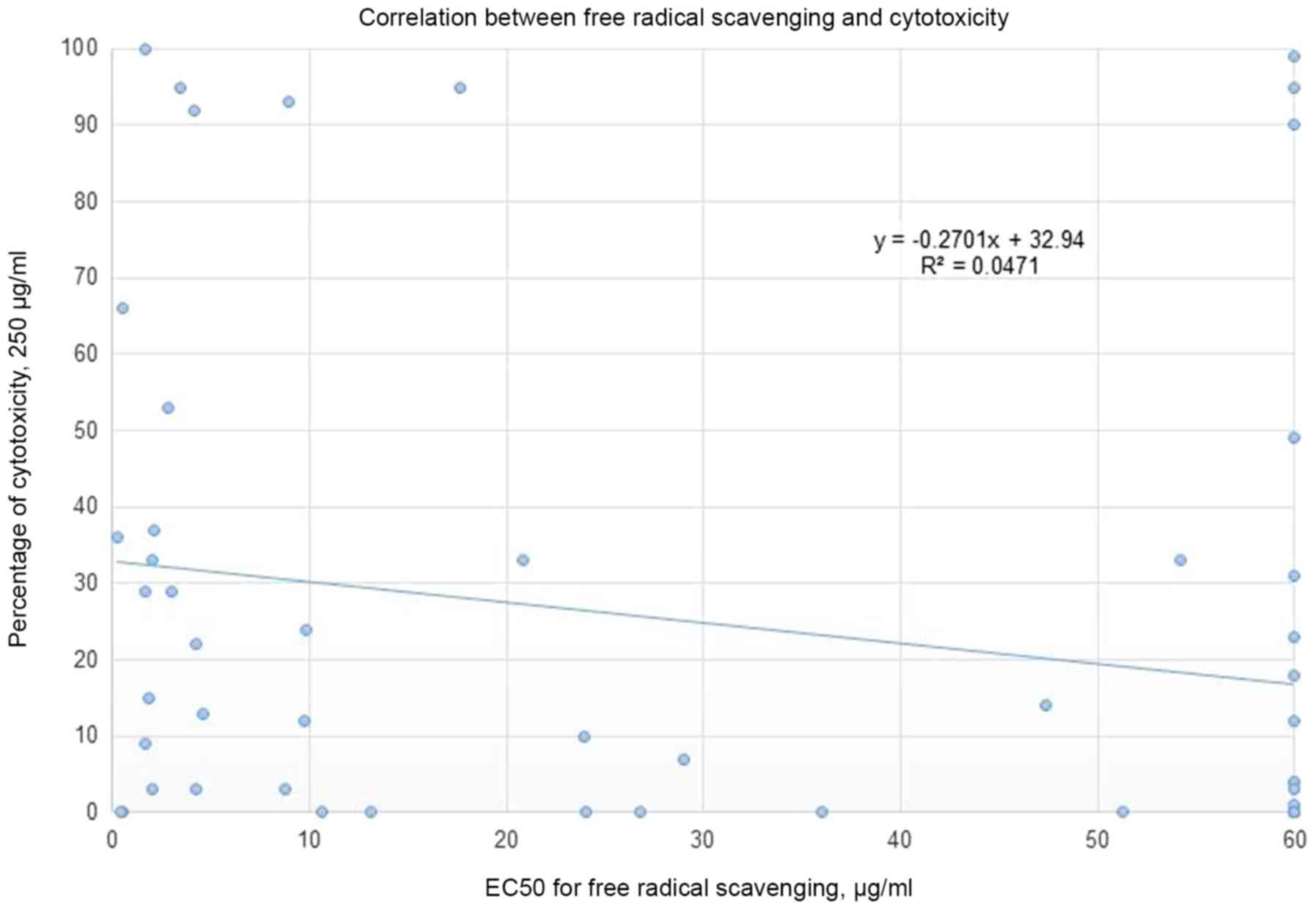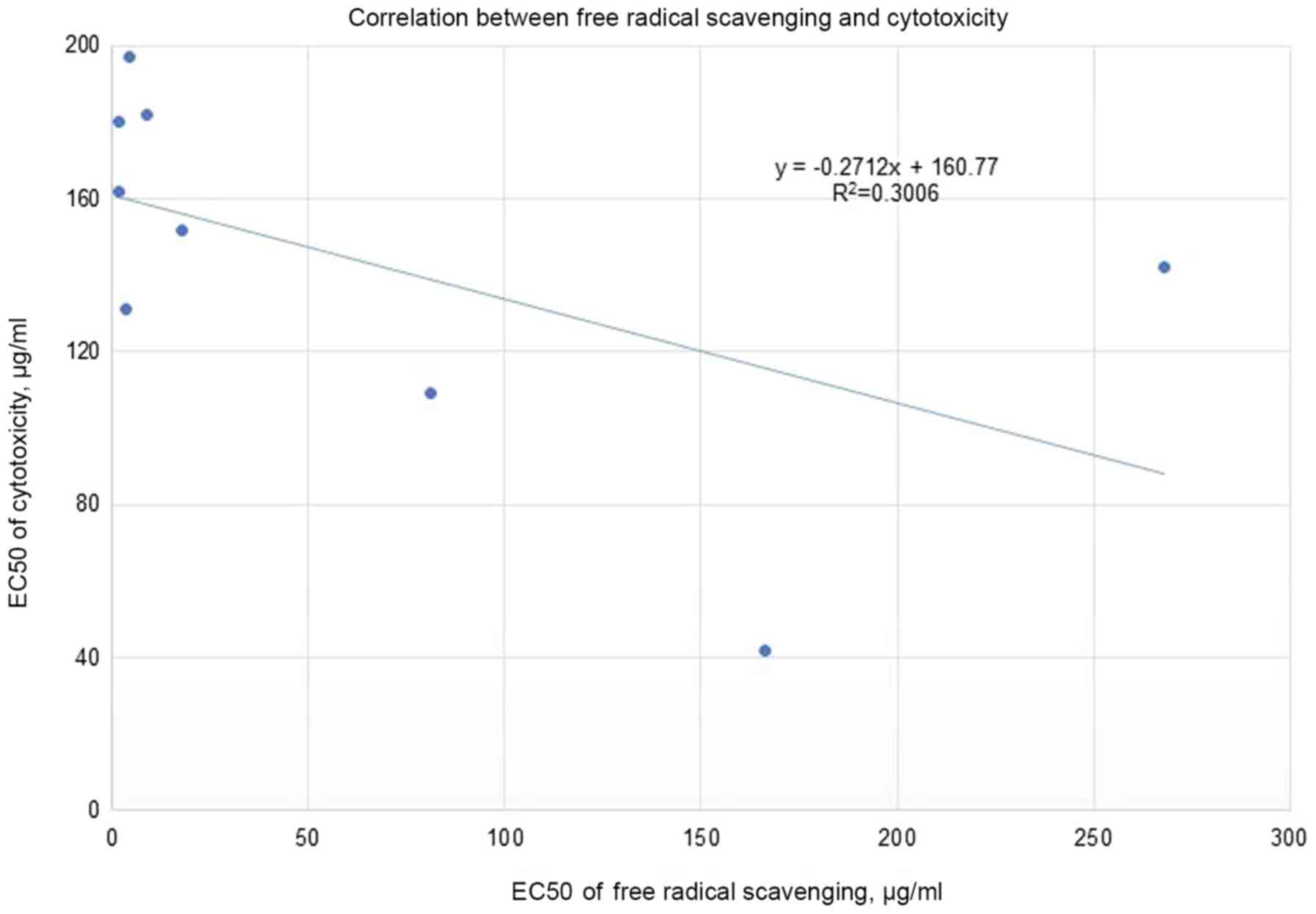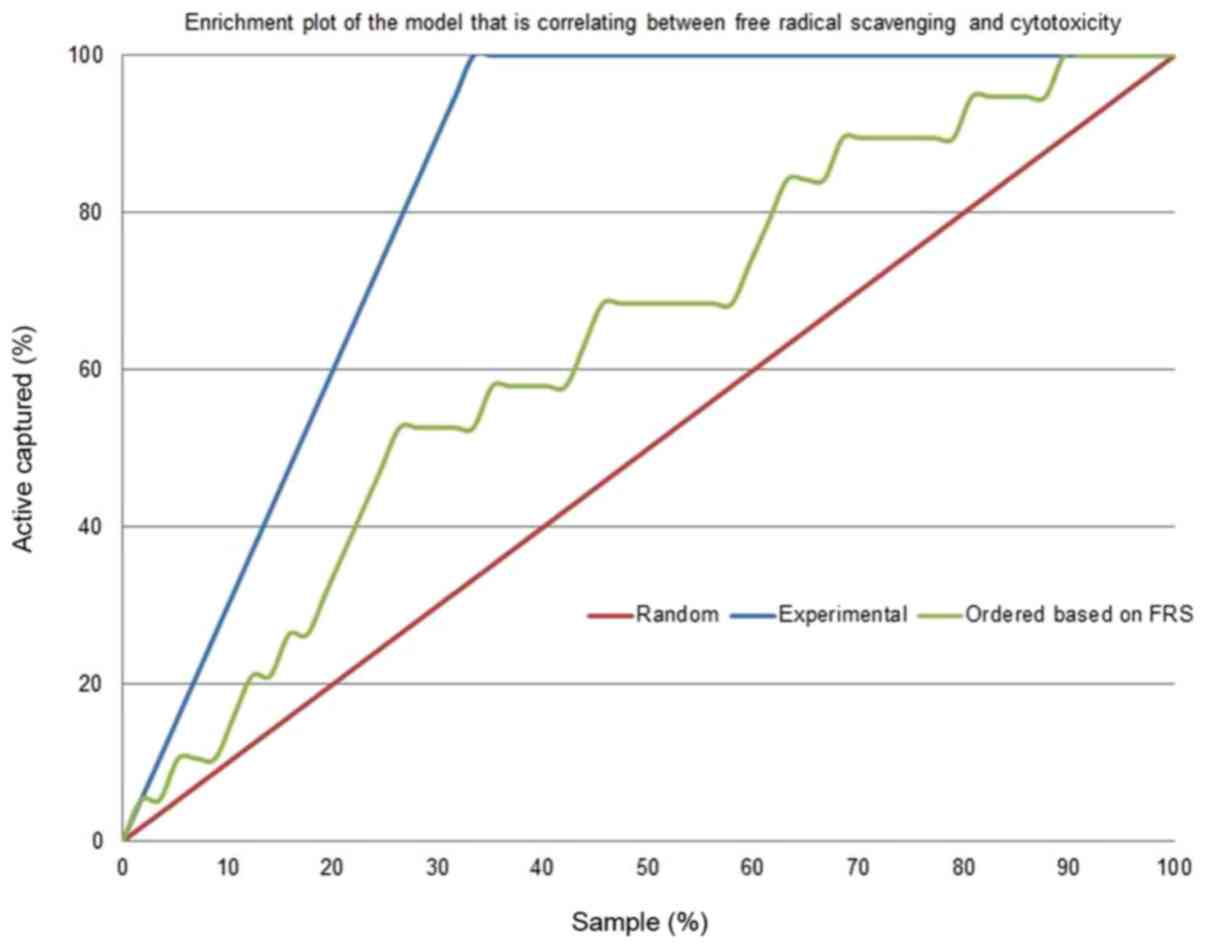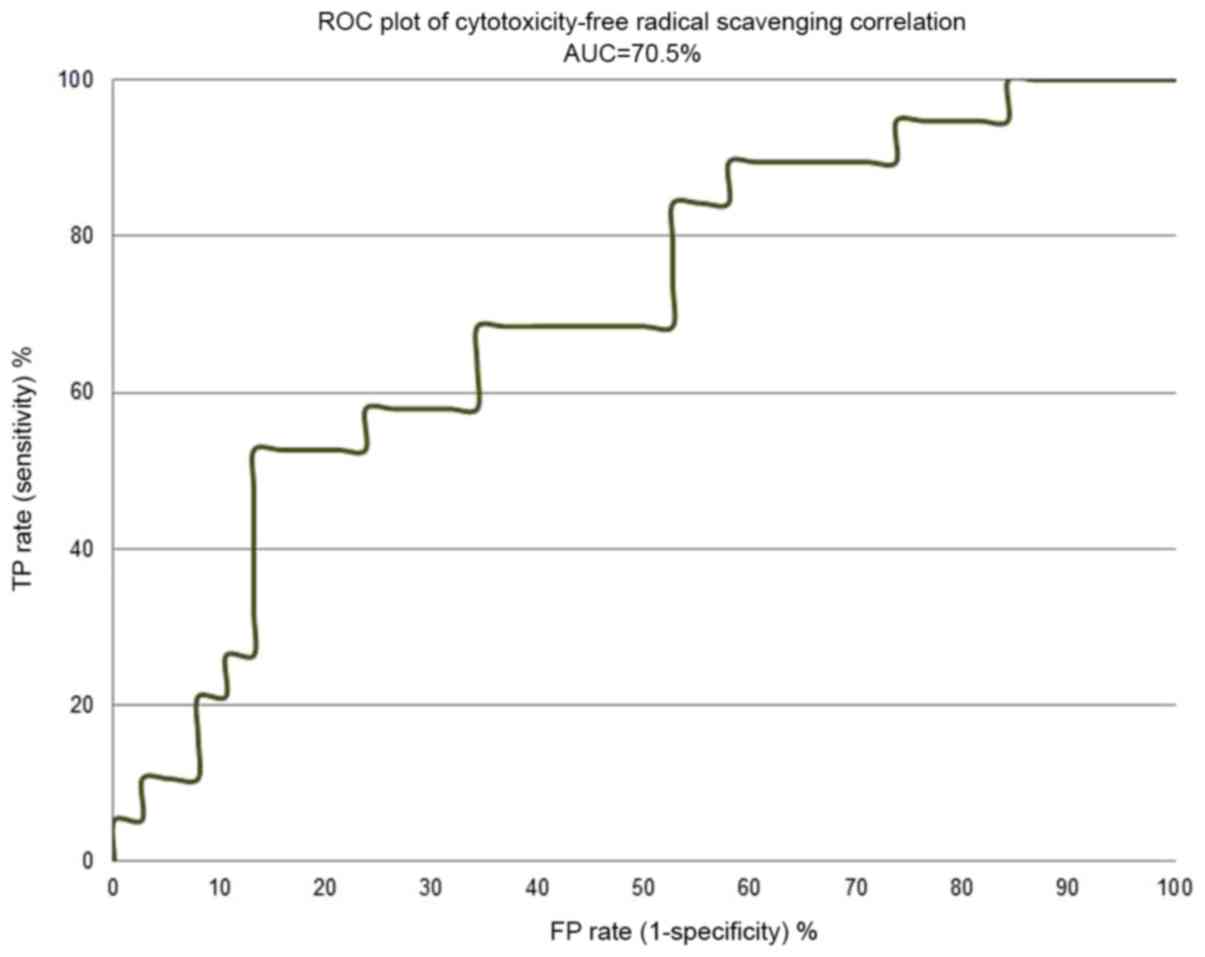|
1
|
Aswad M, Rayan M, Abu-Lafi S, Falah M,
Raiyn J, Abdallah Z and Rayan A: Nature is the best source of
anti-inflammatory drugs: Indexing natural products for their
anti-inflammatory bioactivity. Inflamm Res. 67:67–75. 2018.
View Article : Google Scholar : PubMed/NCBI
|
|
2
|
Frank A, Abu-Lafi S, Adawi A, Schwed JS,
Stark H and Rayan A: From medicinal plant extracts to defined
chemical compounds targeting the histamine H4 receptor: Curcuma
longa in the treatment of inflammation. Inflamm Res. 66:923–929.
2017. View Article : Google Scholar : PubMed/NCBI
|
|
3
|
Zaid H, Raiyn J, Osman M, Falah M, Srouji
S and Rayan A: In silico modeling techniques for predicting the
tertiary structure of human H4 receptor. Front Biosci (Landmark
Ed). 21:597–619. 2016. View
Article : Google Scholar : PubMed/NCBI
|
|
4
|
Zeidan M, Rayan M, Zeidan N, Falah M and
Rayan A: Indexing natural products for their potential
anti-diabetic activity: Filtering and mapping discriminative
physicochemical properties. Molecules. 22:E15632017. View Article : Google Scholar : PubMed/NCBI
|
|
5
|
Sui YB, Liu L, Tian QY, Deng XW, Zhang YQ
and Li ZG: A retrospective study of traditional Chinese medicine as
an adjunctive therapy for patients with chronic heart failure.
Medicine (Baltimore). 97:e116962018. View Article : Google Scholar : PubMed/NCBI
|
|
6
|
Maiti P and Dunbar GL: Use of curcumin, a
natural polyphenol for targeting molecular pathways in treating
age-related neurodegenerative diseases. Int J Mol Sci.
19:E16372018. View Article : Google Scholar : PubMed/NCBI
|
|
7
|
Masalha M, Rayan M, Adawi A, Abdallah Z
and Rayan A: Capturing antibacterial natural products with in
silico techniques. Mol Med Rep. 18:763–770. 2018.PubMed/NCBI
|
|
8
|
Kacergius T, Abu-Lafi S, Kirkliauskiene A,
Gabe V, Adawi A, Rayan M, Qutob M, Stukas R, Utkus A, Zeidan M and
Rayan A: Inhibitory capacity of Rhus coriaria L. extract and
its major component methyl gallate on Streptococcus mutans
biofilm formation by optical profilometry: Potential applications
for oral health. Mol Med Rep. 16:949–956. 2017. View Article : Google Scholar : PubMed/NCBI
|
|
9
|
Vallejo MJ, Salazar L and Grijalva M:
Oxidative stress modulation and ROS-mediated toxicity in cancer: A
review on in vitro models for plant-derived compounds. Oxid Med
Cell Longev. 2017:45860682017. View Article : Google Scholar : PubMed/NCBI
|
|
10
|
Chikara S, Nagaprashantha LD, Singhal J,
Horne D, Awasthi S and Singhal SS: Oxidative stress and dietary
phytochemicals: Role in cancer chemoprevention and treatment.
Cancer Lett. 413:122–134. 2018. View Article : Google Scholar : PubMed/NCBI
|
|
11
|
Gavamukulya Y, Wamunyokoli F and El-Shemy
HA: Annona muricata: Is the natural therapy to most disease
conditions including cancer growing in our backyard? A systematic
review of its research history and future prospects. Asian Pac J
Trop Med. 10:835–848. 2017. View Article : Google Scholar : PubMed/NCBI
|
|
12
|
Kapinova A, Stefanicka P, Kubatka P, Zubor
P, Uramova S, Kello M, Mojzis J, Blahutova D, Qaradakhi T, Zulli A,
et al: Are plant-based functional foods better choice against
cancer than single phytochemicals? A critical review of current
breast cancer research. Biomed Pharmacother. 96:1465–1477. 2017.
View Article : Google Scholar : PubMed/NCBI
|
|
13
|
Rayan A, Raiyn J and Falah M: Nature is
the best source of anticancer drugs: Indexing natural products for
their anticancer bioactivity. PLoS One. 12:e01879252017. View Article : Google Scholar : PubMed/NCBI
|
|
14
|
Tariq A, Sadia S, Pan K, Ullah I, Mussarat
S, Sun F, Abiodun OO, Batbaatar A, Li Z, Song D, et al: A
systematic review on ethnomedicines of anti-cancer plants.
Phytother Res. 31:202–264. 2017. View Article : Google Scholar : PubMed/NCBI
|
|
15
|
Aggarwal BB and Shishodia S: Molecular
targets of dietary agents for prevention and therapy of cancer.
Biochem Pharmacol. 71:1397–1421. 2006. View Article : Google Scholar : PubMed/NCBI
|
|
16
|
Raza A and Sood GK: Hepatocellular
carcinoma review: Current treatment, and evidence-based medicine.
World J Gastroenterol. 20:4115–4127. 2014. View Article : Google Scholar : PubMed/NCBI
|
|
17
|
Ali H, Dixit S, Ali D, Alqahtani SM,
Alkahtani S and Alarifi S: Isolation and evaluation of anticancer
efficacy of stigmasterol in a mouse model of DMBA-induced skin
carcinoma. Drug Des Devel Ther. 9:2793–2800. 2015. View Article : Google Scholar : PubMed/NCBI
|
|
18
|
Ziech D, Franco R, Georgakilas AG,
Georgakila S, Malamou-Mitsi V, Schoneveld O, Pappa A and
Panayiotidis MI: The role of reactive oxygen species and oxidative
stress in environmental carcinogenesis and biomarker development.
Chem Biol Interact. 188:334–339. 2010. View Article : Google Scholar : PubMed/NCBI
|
|
19
|
Galaris D, Skiada V and Barbouti A: Redox
signaling and cancer: The role of ‘labile’ iron. Cancer Lett.
266:21–29. 2008. View Article : Google Scholar : PubMed/NCBI
|
|
20
|
Jambunathan S, Bangarusamy D, Padma PR and
Sundaravadivelu S: Cytotoxic activity of the methanolic extract of
leaves and rhizomes of Curcuma amada Roxb against breast cancer
cell lines. Asian Pac J Trop Med. 7S1:S405–S409. 2014. View Article : Google Scholar : PubMed/NCBI
|
|
21
|
Fuchs-Tarlovsky V: Role of antioxidants in
cancer therapy. Nutrition. 29:15–21. 2013. View Article : Google Scholar : PubMed/NCBI
|
|
22
|
Chua MT, Tung YT and Chang ST: Antioxidant
activities of ethanolic extracts from the twigs of Cinnamomum
osmophloeum. Bioresour Technol. 99:1918–1925. 2008. View Article : Google Scholar : PubMed/NCBI
|
|
23
|
Abu-Lafi S, Rayan B, Kadan S, Abu-Lafi M
and Rayan A: Anticancer activity and phytochemical composition of
wild Gundelia tournefortii. Oncol Lett. 17:713–717.
2019.PubMed/NCBI
|
|
24
|
Hwang YJ, Lee EJ, Kim HR and Hwang KA: In
vitro antioxidant and anticancer effects of solvent fractions from
Prunella vulgaris var. lilacina. BMC Complement Altern Med.
13:3102013. View Article : Google Scholar : PubMed/NCBI
|
|
25
|
Radomska-Leśniewska DM, Hevelke A,
Skopiński P, Bałan B, Jóźwiak J, Rokicki D, Skopińska-Różewska E
and Białoszewska A: Reactive oxygen species and synthetic
antioxidants as angiogenesis modulators: Clinical implications.
Pharmacol Rep. 68:462–471. 2016. View Article : Google Scholar : PubMed/NCBI
|
|
26
|
Boots AW, Haenen GR and Bast A: Health
effects of quercetin: From antioxidant to nutraceutical. Eur J
Pharmacol. 585:325–337. 2008. View Article : Google Scholar : PubMed/NCBI
|
|
27
|
Kadan S, Rayan M and Rayan A: Anticancer
Activity of Anise (Pimpinella anisum L.) Seed Extract. Open
Nutraceuticals J. 6:1–5. 2013. View Article : Google Scholar
|
|
28
|
Zaid H, Rayan A, Said O and Saad B: Cancer
treatment by Greco-Arab and Islamic herbal medicine. Open
Nutraceuticals J. 3:203–213. 2010. View Article : Google Scholar
|
|
29
|
Uttara B, Singh AV, Zamboni P and Mahajan
RT: Oxidative stress and neurodegenerative diseases: A review of
upstream and downstream antioxidant therapeutic options. Curr
Neuropharmacol. 7:65–74. 2009. View Article : Google Scholar : PubMed/NCBI
|
|
30
|
Perrone S, Santacroce A, Longini M,
Proietti F, Bazzini F and Buonocore G: The free radical diseases of
prematurity: From cellular mechanisms to bedside. Oxid Med Cell
Longev. 2018:74830622018. View Article : Google Scholar : PubMed/NCBI
|
|
31
|
Valko M, Leibfritz D, Moncol J, Cronin MT,
Mazur M and Telser J: Free radicals and antioxidants in normal
physiological functions and human disease. Int J Biochem Cell Biol.
39:44–84. 2007. View Article : Google Scholar : PubMed/NCBI
|
|
32
|
Abu-Lafi S, Rayan M, Masalha M, Abu-Farich
B, Al-Jaas H, Abu-Lafi M and Rayan A: Phytochemical composition and
biological activities of wild Scolymus maculatus L.
Medicines (Basel). 6:E532019. View Article : Google Scholar : PubMed/NCBI
|
|
33
|
Masalha M, Abu-Lafi S, Abu-Farich B, Rayan
M, Issa N, Zeidan M and Rayan A: A new approach for indexing honey
for its heath/medicinal benefits: Visualization of the concept by
indexing based on antioxidant and antibacterial activities.
Medicines (Basel). 5:E1352018. View Article : Google Scholar : PubMed/NCBI
|
|
34
|
Moore J, Yousef M and Tsiani E: Anticancer
effects of rosemary (Rosmarinus officinalis L.) extract and
rosemary extract polyphenols. Nutrients. 8:E7312016. View Article : Google Scholar : PubMed/NCBI
|
|
35
|
Gonzalez-Vallinas M, Reglero G and Ramirez
de Molina A: Rosemary (Rosmarinus officinalis L.) extract as
a potential complementary agent in anticancer therapy. Nutr Cancer.
67:1221–1229. 2015. View Article : Google Scholar : PubMed/NCBI
|
|
36
|
Swamy MK, Sinniah UR and Ghasemzadeh A:
Anticancer potential of rosmarinic acid and its improved production
through biotechnological interventions and functional genomics.
Appl Microbiol Biotechnol. 102:7775–7793. 2018. View Article : Google Scholar : PubMed/NCBI
|
|
37
|
Shrestha S, Song YW, Kim H, Lee DS and Cho
SK: Sageone, a diterpene from Rosmarinus officinalis,
synergizes with cisplatin cytotoxicity in SNU-1 human gastric
cancer cells. Phytomedicine. 23:1671–1679. 2016. View Article : Google Scholar : PubMed/NCBI
|
|
38
|
Elshafie HS, Armentano MF, Carmosino M,
Bufo SA, De Feo V and Camele I: Cytotoxic activity of Origanum
Vulgare L. on hepatocellular carcinoma cell line HepG2 and
evaluation of its biological activity. Molecules. 22:E14352017.
View Article : Google Scholar : PubMed/NCBI
|
|
39
|
Ramos PA, Guerra AR, Guerreiro O, Santos
SA, Oliveira H, Freire CS, Silvestre AJ and Duarte MF:
Antiproliferative Effects of Cynara cardunculus L. var.
altilis (DC) lipophilic extracts. Int J Mol Sci. 18:E632016.
View Article : Google Scholar : PubMed/NCBI
|
|
40
|
Bahramsoltani R, Rostamiasrabadi P,
Shahpiri Z, Marques AM, Rahimi R and Farzaei MH: Aloysia
citrodora Palau (Lemon verbena): A review of phytochemistry and
pharmacology. J Ethnopharmacol. 222:34–51. 2018. View Article : Google Scholar : PubMed/NCBI
|
|
41
|
Elkady AI, Abu-Zinadah OA and Hussein R:
Crude flavonoid extract of medicinal herb Zingibar
officinale inhibits proliferation and induces apoptosis in
hepatocellular carcinoma cells. Oncol Res. 25:897–912. 2017.
View Article : Google Scholar : PubMed/NCBI
|
|
42
|
Lin CY, Hsieh YH, Yang SF, Chu SC, Chen PN
and Hsieh YS: Cinnamomum cassia extracts reverses
TGF-β1-induced epithelial-mesenchymal transition in human lung
adenocarcinoma cells and suppresses tumor growth in vivo. Environ
Toxicol. 32:1878–1887. 2017. View Article : Google Scholar : PubMed/NCBI
|
|
43
|
Berrington D and Lall N: Anticancer
activity of certain herbs and spices on the cervical epithelial
carcinoma (HeLa) cell line. Evid Based Complement Alternat Med.
2012:5649272012. View Article : Google Scholar : PubMed/NCBI
|
|
44
|
Jiang Y, Zhang L and Rupasinghe HP:
Antiproliferative effects of extracts from Salvia
officinalis L. and Saliva miltiorrhiza Bunge on
hepatocellular carcinoma cells. Biomed Pharmacother. 85:57–67.
2017. View Article : Google Scholar : PubMed/NCBI
|
|
45
|
Kikuchi H, Yuan B, Nishimura Y, Imai M,
Furutani R, Kamoi S, Seno M, Fukushima S, Hazama S, Hirobe C, et
al: Cytotoxicity of Vitex agnus-castus fruit extract and its
major component, casticin, correlates with differentiation status
in leukemia cell lines. Int J Oncol. 43:1976–1984. 2013. View Article : Google Scholar : PubMed/NCBI
|















